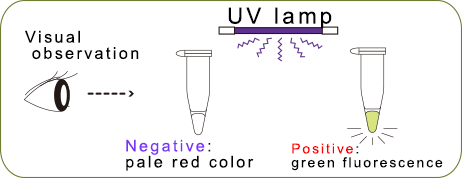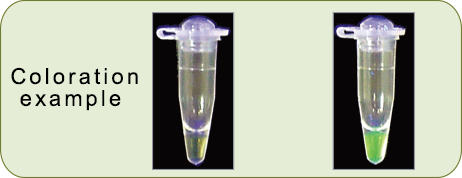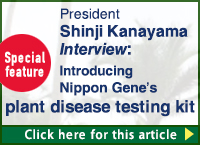Cassava
キャッサバの病気、タピオカ、キャッサバベゴモウイルス、コナジラミ、ジェミニウイルス科、植物病、植物病検査、検査サービス
Can you come up with food made from cassava potatoes?
The most famous cassava-based food is “bubble tea” filled with tapioca balls, which caused a huge boom nationwide. This tapioca, is made from cassava potatoes.
Cassava is a plant that can grow in harsh environment even in an arid land. Therefore, cassava is expected as a substitute food in case of a food shortage and also to prevent global warming.
Cassava is a plant that is indispensable for people’s basic eating habit, as one of the staple foods, in many countries. The reduction of the yield due to plant disease causes a great economic loss, so early detection of plant disease is essential to resolve the yield reduction. For that purpose, a genetic test kit for testing with high sensitivity is required. Nippon Gene offers a kit in our plant testing product line-up for cassava disease testing.
Cassava begomovirus (Asian strain)
- Plant virus that reduces cassava yield
- Mediated by whiteflies
- It is important to find and discard infected cassava at an early stage
The begomovirus genus of the geminiviridae family that causes cassava mosaic disease which reduces the yield of cassava, is roughly divided into two strains: one strain in Africa and one strain in Asia.
Moreover, there are two known viruses belonging to Asian strains, one is Sri Lankan cassava mosaic virus (SLCMV) and another is Indian cassava mosaic virus (ICMV). Our testing kit is designed to detect both of these Asian strains.
Kit explanation
DryADD™ Cassava Begomovirus (Asian strain) Universal Detection LAMP Kit
This kit uses the LAMP method to comprehensively detect Asian strains of the genus Begomovirus in the family Geminiviridae. Our drying technology has made it possible to supply and use the reagent in all parts of the world where transport and storage of reagents has been difficult due to lack of freezing and refrigeration facilities.
Features
Shipping and long-term storage* at room temperature are possible
*Original performance (after manufacturing) is maintained after long-term storage at 25 ° C or 45 ° C (stable as frozen-stored liquid reagent)
Packaged individually for each test and can be used immediately after dissolution
Preformulated for reducing contamination risk and human error during reaction mixture preparation
Price
| Product name | Packing unit | Price |
|---|---|---|
| DryADD™ Cassava Begomovirus (Asian strain) Universal Detection LAMP Kit | 48 tests | please inquire |
DryADD™ Cassava Begomovirus (Asian strain) Universal Detection LAMP Kit
| Component | Qty (48 tests) | Storage | Remarks |
|---|---|---|---|
| C.B.U. Detection Dry Reagent | 8 well × 6 strips | Room Temp. | |
| C.B.U. Reagent Dissolve Solution | 400 μl × 6 tubes | Room Temp. | Recommended to use a new tube after every test |
| C.B.U. Positive Control | 6 tubes | Room Temp. | Recommended to use a new tube after every test . |
| C.B.U. Control Dissolve Solution | 400 μl × 1 tube | Room Temp. | |
| Mineral oil | 400 μl × 6 tubes | Room Temp. | Recommended to use a new tube after every test |
Shipping temperature
This product is shipped at room temperature.
Instructions
* Please carry out each process in the order of A→B→C, do not proceed the process simultaneously
Step A: Preparation of a DNA sample
A-1. Prepare a DNA sample from the target plant.
* For the “Sampling sites” and “DNA extraction method (plant DNA extraction kit, CTAB method, etc.)”, please consider using the extraction method suitable for the target plant.
*Please use the solution which is used to elute or dissolve the DNA sample as a negative control.
<Step B: Preparation of positive control>
B-1. Take one tube of C.B.U. positive control out from the package.
B-2. Add 10 μl of positive control dissolving solution, and briefly spin down the tube.
B-3. Leave the tube at room temperature for 5 minutes.
B-4. Vortex the tube and spin down (use the resulting solution as positive control solution).
<Step C: Preparation of test solution and LAMP reaction>
C-1. Take required number of C.B.U. dry reagent for detection strip out from the package and place it on ice.
C-2. Take C.B.U. dry reagent dissolving solution and mineral oil out from the package.
C-3. Add 23 μl of C.B.U. dry reagent dissolving solution to each tube, spin down to collect the solution at the bottom, and leave on ice for 2 minutes.
C-4. Add 2 μl of DNA sample to one of the tubes. Add 2 μl of negative control and C.B.U. positive control to the other tubes separately. When the samples are aliquoted, overlay with 20 μl of mineral oil to each tube and close the cap.
*When using a thermal cycler equipped with hot bonnet, it is not necessary to add mineral oil.
C-5. Briefly spin down after mixing by inversion and perform the LAMP reaction at 66 ℃ for 60 minutes (testing reaction).
C-8. Terminate the reaction by heating at 80 ℃ for 2 minutes.
C-9. Make a judgment.


Remarks
This product is a reagent only for testing and research use. Do not use for medical applications.
License
-The LAMP method is patented by Eiken Chemical Co., Ltd. Nippon Gene Material Co., Ltd. is licensed to develop, manufacture, and commercialize cassava begomovirus detection kits using the LAMP method.
The product name has been changed from former “-LAMP Dry Premix- Cassava Begomovirus (Asian strain) universal detection kit”, while there is no change in the product content.
* The linked page may be in Japanese, please use the translation function of the browser.




